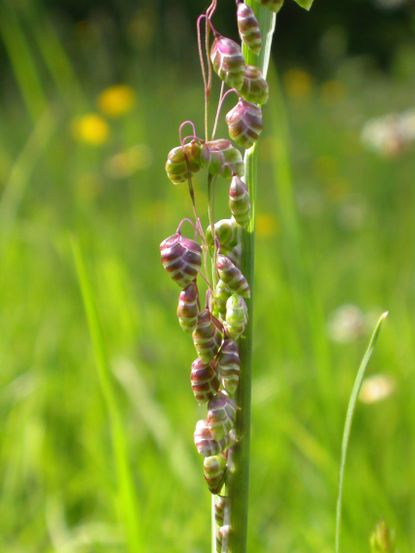Rattlesnake Quaking Grass Info: Care Of Ornamental Quaking Grass


By Mary Dyer, Master Naturalist and Master Gardener Looking for an ornamental grass that offers unique interest? Why not consider growing rattlesnake grass, also known as quaking grass. Read on to learn how to grow rattlesnake grass and take advantage of this fun plant.
Quaking Grass Information
What is rattlesnake grass? Native to the Mediterranean, this ornamental quaking grass (Briza maxima) consists of neat clumps that reach mature heights of 12 to 18 inches (31-46 cm.). Tiny blooms shaped like rattlesnake rattles dangle from slender, graceful stems rising above the grass, providing color and movement as they shimmer and rattle in the breeze-- and gives rise to its common names. Also known as rattlesnake quaking grass, this plant is available both in perennial and annual varieties. Rattlesnake quaking grass is readily found in most garden centers and nurseries, or you can propagate the plant by scattering seeds on prepared soil. Once established, the plant self-seeds readily.
How to Grow Rattlesnake Grass
Although this hardy plant tolerates partial shade, it performs best and produces more blooms in full sunlight. Rattlesnake grass needs rich, moist soil. Dig 2 to 4 inches (5-10 cm.) of mulch or compost into the planting area if the soil is poor or doesn't drain well. Water regularly while new roots grow during the first year. Water deeply to saturate the roots, and then let the top 1 to 2 inches (2.5-5 cm.) of soil dry before watering again. Once established, rattlesnake grass is drought tolerant and needs water only during hot, dry weather. Rattlesnake quaking grass generally doesn't require fertilizer and too much creates a floppy, weak plant. If you think your plant needs fertilizer, apply a dry general-purpose, slow-release fertilizer at planting time and as soon as new growth appears every spring. Use no more than one-fourth to one-half cup (60-120 ml.) per plant. Be sure to water after applying fertilizer. To keep the plant neat and healthy, cut the grass down to a height of 3 to 4 inches (8-10 cm.) before new growth emerges in spring. Don't cut the plant down in autumn; the clumps of dry grass add texture and interest to the winter garden and protect the roots during the winter. Dig and divide rattlesnake grass in spring if the clump looks overgrown or if the grass dies down in the center. Discard the unproductive center and plant the divisions in a new location or give them to plant-loving friends.
Gardening tips, videos, info and more delivered right to your inbox!
Sign up for the Gardening Know How newsletter today and receive a free download of our most popular eBook "How to Grow Delicious Tomatoes."

A Credentialed Garden Writer, Mary H. Dyer was with Gardening Know How in the very beginning, publishing articles as early as 2007.
-
 Clever Vertical Vegetable Garden Ideas For Small Spaces – 7 Ways To Save Space
Clever Vertical Vegetable Garden Ideas For Small Spaces – 7 Ways To Save SpaceShort on garden space? Learn some vegetable garden ideas for small spaces that are fun and easy.
By Mary Ellen Ellis
-
 26 Different Types Of Orchids – With Pictures & Information
26 Different Types Of Orchids – With Pictures & InformationDiscover stunning orchid types to grow in your home and garden – from easy beginner varieties to rare and exotic species that are the preserve of experts.
By Melanie Griffiths